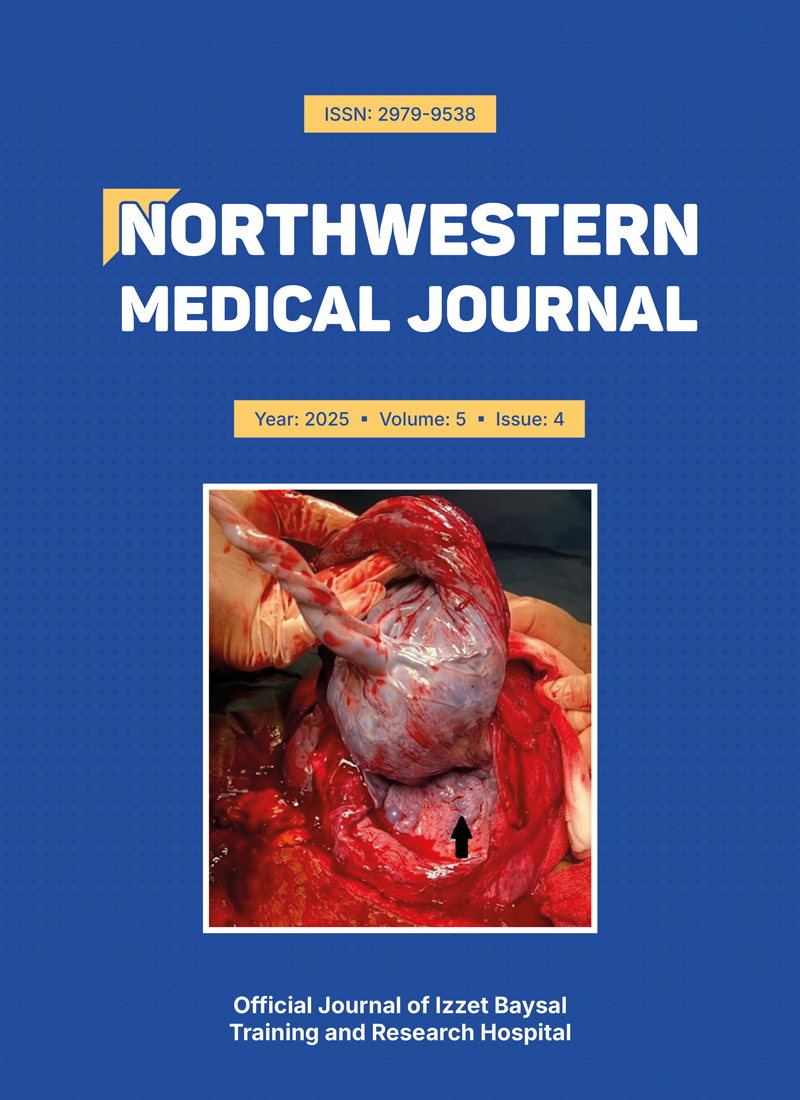Abstract
Aim: The azygos lobe is a well-known anatomical variation of the lung, formed due to the aberrant course of the azygos vein during fetal development. The incidence of the azygos lobe has been reported to be between 0.4% and 1%. This study aims to identify the prevalence of the azygos lobe in a specific patient population, classify its variations, and highlight its importance in differential diagnosis and associated pathologies.
Methods: A retrospective analysis was conducted on 4,549 patients who visited our pulmonology clinic between April 2014 and November 2017. The presence of an azygos lobe was identified through radiological screening.
Results: Among the 4,549 patients screened, 14 cases (0.31%) of azygos lobe were detected, comprising 10 males and four females. The azygos lobe was classified based on the course of the azygos fissure: Type A (lateral to the lung apex) in seven cases (50%), Type B (midline and more vertical) in three cases (21%), and Type C (medial, extending into the mediastinum) in four cases (29%). Additionally, 12 cases (85.7%) were located on the right side, while two cases (14.3%) were on the left.
Conclusions: The azygos lobe is most commonly detected incidentally during imaging for unrelated conditions. Our study emphasizes the importance of recognizing the azygos lobe as a differential diagnosis and investigating potential coexisting pathologies. The findings contribute to existing statistical data on the prevalence and anatomical variations of the azygos lobe.
Keywords: azygos lobe, anatomical variation, differential diagnosis, pulmonary imaging
Copyright and license
Copyright © 2025 The Author(s). This is an open-access article published by Bolu İzzet Baysal Training and Research Hospital under the terms of the Creative Commons Attribution License (CC BY) which permits unrestricted use, distribution, and reproduction in any medium or format, provided the original work is properly cited.
How to cite
References
- Kılıç C, Kocabıyık N, Yalçın B, Kırıcı Y, Yazar F, Ozan H. Accessory fissures of the lungs. Med J SDU. 2009; 13(3): 12-6.
- Meenakshi S, Manjunath KY, Balasubramanyam V. Morphological variations of the lung fissures and lobes. Indian J Chest Dis Allied Sci. 2004; 46(3): 179-82.
- BOYDEN EA. The distribution of bronchi in gross anomalies of the right upper lobe particularly lobes subdivided by the azygos vein and those containing pre-eparterial bronchi. Radiology. 1952; 58(6): 797-807. https://doi.org/10.1148/58.6.797
- Ariyürek OM, Gülsün M, Demirkazik FB. Accessory fissures of the lung: evaluation by high-resolution computed tomography. Eur Radiol. 2001; 11(12): 2449-53. https://doi.org/10.1007/s003300100852
- Aziz A, Ashizawa K, Nagaoki K, Hayashi K. High resolution CT anatomy of the pulmonary fissures. J Thorac Imaging. 2004; 19(3): 186-91. https://doi.org/10.1097/01.rti.0000131590.74658.24
- Etter LE. Variations in the position of the azygos septum and its incidence in 50,000 roentgen examinations. Am J Roentgenol Radium Ther. 1947; 58(6): 726-9.
- Postmus PE, Kerstjens JM, Breed A, vd Jagt E. A family with lobus venae azygos. Chest. 1986; 90(2): 298-9. https://doi.org/10.1378/chest.90.2.298
- Fisher MS. Re: Adam’s lobe. Radiology. 1985; 154(2): 547. https://doi.org/10.1148/radiology.154.2.3966147
- Takasugi JE, Godwin JD. Left azygos lobe. Radiology. 1989; 171(1): 133-4. https://doi.org/10.1148/radiology.171.1.2928516
- Kobayashi T, Satoh K, Kawase Y, et al. Bronchial and vascular supply in azygos lobe of inflated fixed lung: a case study. Radiat Med. 1995; 13(1): 31-3.
- Mata J, Cáceres J, Alegret X, Coscojuela P, De Marcos JA. Imaging of the azygos lobe: normal anatomy and variations. AJR Am J Roentgenol. 1991; 156(5): 931-7. https://doi.org/10.2214/ajr.156.5.2017954
- Kauffman P, Wolosker N, de Campos JRM, Yazbek G, Jatene FB. Azygos lobe: a difficulty in video-assisted thoracic sympathectomy. Ann Thorac Surg. 2010; 89(6): e57-9. https://doi.org/10.1016/j.athoracsur.2010.03.030
- Karre PR, Cooper GB. The azygos lobe and vein: interesting and typical clinical image. BMJ Case Rep. 2011; 2011: bcr0520114266. https://doi.org/10.1136/bcr.05.2011.4266
- Stibbe EP. The Accessory Pulmonary Lobe of the Vena Azygos. J Anat. 1919; 53(Pt 4): 305-14.
- Gürkök S, Gözübüyük A, Yücel O, Çaylak H, Dakak M. Bullous azygos lobe: case report. Turk Gogus Kalp Damar Cerrahisi Derg. 2007; 15(2): 168-9.
- Monaco M, Barone M, Barresi P, Carditello A, Pavia R, Mondello B. Azygos lobe and spontaneous pneumothorax. G Chir. 2000; 21(11-12): 457-8.
- Fukuhara S, Montgomery M, Reyes A. Robot-assisted azygos lobectomy for adenocarcinoma arising in an azygos lobe. Interact Cardiovasc Thorac Surg. 2013; 16(5): 715-7. https://doi.org/10.1093/icvts/ivt021
- Sadikot RT, Cowen ME, Arnold AG. Spontaneous pneumothorax in a patient with an azygos lobe. Thorax. 1997; 52(6): 579-80; discussion 575-6. https://doi.org/10.1136/thx.52.6.579
- Caceres J, Mata JM, Andreu J. The azygos lobe: normal variants that may simulate disease. Eur J Radiol. 1998; 27(1): 15-20. https://doi.org/10.1016/s0720-048x(97)00146-0











